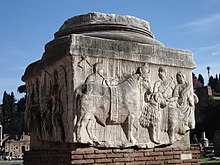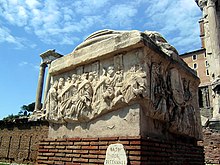
The Tetrarchy was the system instituted by Roman emperor Diocletian in 293 AD to govern the ancient Roman Empire by dividing it between two emperors, the augusti, and their junior colleagues and designated successors, the caesares. This marked the end of the Crisis of the Third Century.

The Roman Forum is a rectangular forum (plaza) surrounded by the ruins of several important ancient government buildings at the center of the city of Rome. Citizens of the ancient city referred to this space, originally a marketplace, as the Forum Magnum, or simply the Forum.
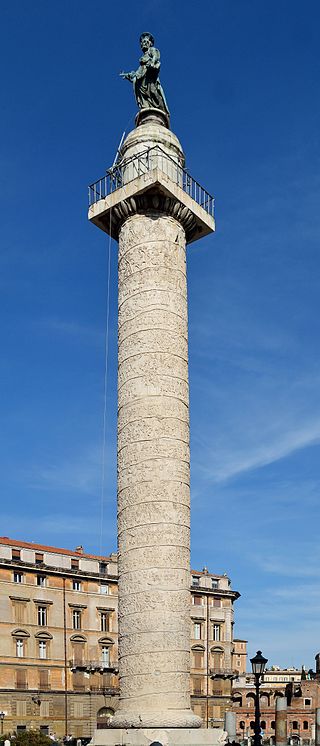
Trajan's Column is a Roman triumphal column in Rome, Italy, that commemorates Roman emperor Trajan's victory in the Dacian Wars. It was probably constructed under the supervision of the architect Apollodorus of Damascus at the order of the Roman Senate. It is located in Trajan's Forum, north of the Roman Forum. Completed in AD 113, the freestanding column is most famous for its spiral bas relief, which depicts the wars between the Romans and Dacians. Its design has inspired numerous victory columns, both ancient and modern.
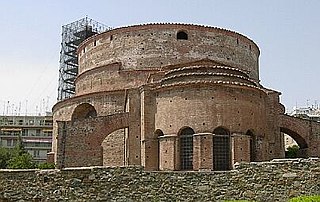
The Arch of Galerius or Kamara (Καμάρα) and the Rotunda (Ροτόντα) are neighbouring early 4th-century AD monuments in the city of Thessaloniki, in the region of Central Macedonia in northern Greece. As an outstanding example of early Byzantine art and architecture, in addition to the importance of the Rotunda as one of the earliest Christian monuments in the Eastern Roman Empire, both sites were inscribed on the UNESCO World Heritage List in 1988 as part of the Paleochristian and Byzantine monuments of Thessaloniki.


The Arch of Constantine is a triumphal arch in Rome dedicated to the emperor Constantine the Great. The arch was commissioned by the Roman Senate to commemorate Constantine's victory over Maxentius at the Battle of Milvian Bridge in AD 312. Situated between the Colosseum and the Palatine Hill, the arch spans the Via Triumphalis, the route taken by victorious military leaders when they entered the city in a triumphal procession. Dedicated in 315, it is the largest Roman triumphal arch, with overall dimensions of 21 m (69 ft) high, 25.9 m (85 ft) wide and 7.4 m (24 ft) deep. It has three bays, the central one being 11.5 m (38 ft) high and 6.5 m (21 ft) wide and the laterals 7.4 m (24 ft) by 3.4 m (11 ft) each. The arch is constructed of brick-faced concrete covered in marble.
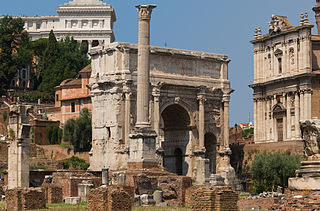
The Arch of Septimius Severus at the northwestern end of the Roman Forum is a white marble triumphal arch dedicated in 203 A.D. to commemorate the Parthian victories of Emperor Septimius Severus and his two sons, Caracalla and Geta, in the two campaigns against the Parthians of 194-195 A.D. and 197–199 A.D. After the death of Septimius Severus, his sons Caracalla and Geta were initially joint emperors. Caracalla had Geta assassinated in 212 A.D.; in the practice now known as damnatio memoriae, Geta's memorials were destroyed and all images or mentions of him were removed from public buildings and monuments. Accordingly, Geta's image and inscriptions referring to him were removed from the arch.

The Temple of Caesar or Temple of Divus Iulius, also known as Temple of the Deified Julius Caesar, delubrum, heroon or Temple of the Comet Star, is an ancient structure in the Roman Forum of Rome, Italy, located near the Regia and the Temple of Vesta.
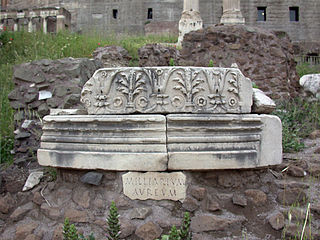
The Milliarium Aureum, also known by the translation Golden Milestone, was a monument, probably of marble or gilded bronze, erected by the Emperor Augustus near the Temple of Saturn in the central Forum of Ancient Rome. All roads were considered to begin at this monument and all distances in the Roman Empire were measured relative to it. On it perhaps were listed all the major cities in the empire and distances to them, though the monument's precise location and inscription remain matters of debate among historians.
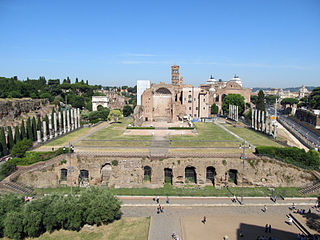
The Temple of Venus and Roma is thought to have been the largest temple in Ancient Rome. Located on the Velian Hill, between the eastern edge of the Forum Romanum and the Colosseum, in Rome, it was dedicated to the goddesses Venus Felix and Roma Aeterna.
The Plutei of Trajan are carved stone balustrades built for the Roman emperor Trajan. They are on display inside the Curia Julia in the Roman Forum today, but are not part of the original structure.

The Column of Phocas is a Roman monumental column in the Roman Forum of Rome, Italy, built when Rome was part of the Eastern Roman Empire after its reconquest from the Kingdom of the Ostrogoths.
Decennalia were Ancient Roman festivals celebrated with games every ten years by the Roman emperors.

The Comitium was the original open-air public meeting space of Ancient Rome, and had major religious and prophetic significance. The name comes from the Latin word for "assembly". The Comitium location at the northwest corner of the Roman Forum was later lost in the city's growth and development, but was rediscovered and excavated by archaeologists at the turn of the twentieth century. Some of Rome's earliest monuments; including the speaking platform known as the Rostra, the Columna Maenia, the Graecostasis and the Tabula Valeria were part of or associated with the Comitium.

The Portrait of the Four Tetrarchs is a porphyry sculpture group of four Roman emperors dating from around 300 AD. The sculptural group has been fixed to a corner of the façade of St Mark's Basilica in Venice, Italy since the Middle Ages. It probably formed part of the decorations of the Philadelphion in Constantinople, and was removed to Venice in 1204 or soon after.

The Shrine of Vulcan, or Vulcanal, or Volcanal, was an 8th-century BC sacred precinct on the future site of the Roman Forum in Rome, modern Italy. Dedicated to Vulcan, the Roman god of fire, it was traditionally considered to commemorate the spot where the legendary figures Romulus and Tatius concluded the peace treaty between the tribes known as the Latins — on the Palatine Hill — and the Sabines — on the Quirinal and Esquiline. This famous merger of the hill-villages was said to be the foundation of the Roman state.
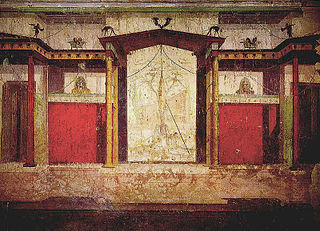
The House of Augustus, or the Domus Augusti, is situated on the Palatine Hill in Rome, Italy. This house has been identified as the primary place of residence for the emperor Augustus.

Pompey's Pillar is the name given to a Roman triumphal column in Alexandria, Egypt. Set up in honour of the Roman emperor Diocletian between 298–302 AD, the giant Corinthian column originally supported a colossal porphyry statue of the emperor in armour. It stands at the eastern side of the temenos of the Serapeum of Alexandria, beside the ruins of the temple of Serapis itself.

The Regio VIII Forum Romanum Magnum is the eighth regio of imperial Rome, under Augustus's administrative reform. Regio VIII took its name from the Roman Forum, the political centre of Ancient Rome.






